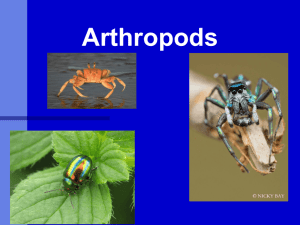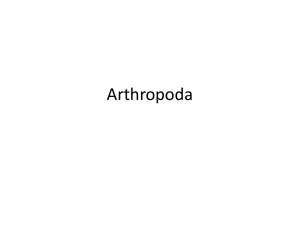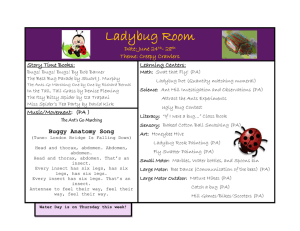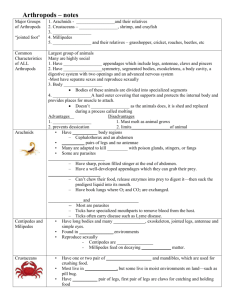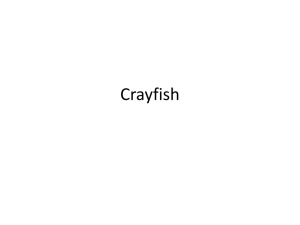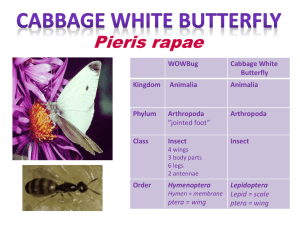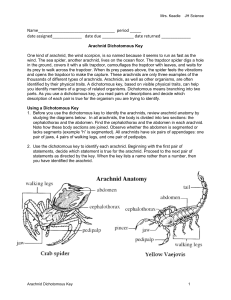Arthropods
advertisement
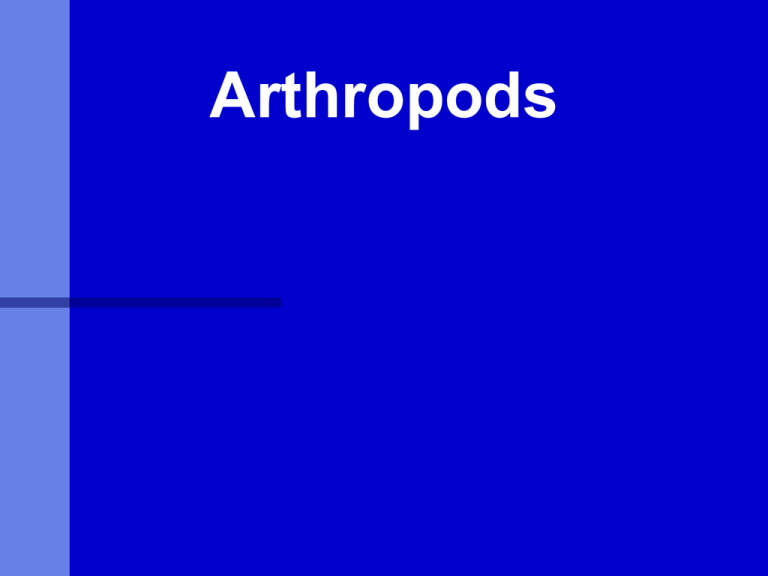
Arthropods What is Entomology? The study of insects (and their near relatives). What are insects (and near relatives)? Insects and their relatives are ARTHROPODS. Review of Zoological Nomenclature (classifying & naming) Taxonomic Categories Phylum Class Order Family Genus Genus & species Review of Zoological Nomenclature Taxonomic Categories Kingdom - Animalae Phylum - Arthropoda Class - Insecta Order - Coleoptera Family - Scarabaeidae Genus - Popillia Genus & species Popillia japonica Newman Characteristics of the Phylum Arthropoda The segmented bodies are arranged into regions, called tagmata (e.g., head, thorax, abdomen). The paired appendages (e.g., legs, antennae) are jointed. They posses a chitinous exoskeletion that must be shed during growth. They have bilateral symmetry. The nervous system is dorsal (belly) and the circulatory system is open and ventral (back). What are some other Animal Phyla? Porifera & Cnidaria – sponges & corals. Platyhelminthes - flatworms, tapeworms Nematoda - roundworms Mollusca - clams, snails & slugs, squids Echinodermata - starfish, sea urchins Annelida - segmented worms (earthworms) Chordata - fish, amphibians, reptiles, birds, mammals Arthropod Groups (taxa) The arthropods are divided into two large groups that exist today: Chelicerates and Mandibulates Chelicerate Arthropod Characters: Pincher-like mouthparts chelicerae - and pedipalps NO antennae Two body regions, usually cephalothorax & abdomen Four pairs of legs Horseshoe crabs and arachnids are only living groups Mandibulate Arthropod Characters: Mouthparts are mandibles - normally chewing sideways One or two pairs of antennae Various body region arrangements cephalothorax & abdomen / head & trunk / head, thorax & abdomen Variable leg numbers Insects, crustaceans & myriapods Orders of Arachnids Scorpions Pseudoscorpions Daddy Long-Legs Mites & Ticks Spiders Pseudoscorpion Scorpion Daddy-long-legs Tick (a mite) Wolf Spider Scorpion Anatomy chelicerae eyes pedipalp Pseudoscorpion Mite and Tick Body Regions pedipalps & chelicerae cephalothorax abdomen American dog tick male Blacklegged (deer) tick female American dog tick female laying egg mass (1000-2000 eggs!). Clover mites Twospotted spider mites Predatory mite daddy long-legs cephalothorax abdomen Spider Anatomy pedipalp chelicera (fang) cephalothorax narrow waist abdomen Jumping Spider Abdomen Cephalothorax Chelicera (fang) Pedipalp Wolf spider with egg case Tarantula Spitting spider Orb-weaving spider Black widow with egg case Brown recluse Classes of Myriapods (many legged arthropods) (all have one pair of antennae, a head region, and trunk with many pairs of legs, use trachea) Diplopoda - millipedes Chilopoda - centipedes Myriapods [one pair of antennae, head & trunk regions, trunk with many pairs of legs] Millipede (Diplopoda) Two pair of legs per visible segment, attached under body. Centipede (Chilopoda) Pair of fangs under head, one pair legs per visible segment - attached to side of body. No fangs, no eyes, legs attached to side of body. Millipede (Diplopoda) Centipede (Chilopoda) Garden centipede Classes of Crustacea • mostly marine, fresh water, a few terrestrial • all have two pair of antennae • five or more pairs of legs • segmented abdominal appendages • head & trunk or cephalothorax & abdomen body arrangement • have gills Sowbugs or pillbugs Sand fleas Barnacles Crabs, lobster, shrimp Crayfish cephalothorax (Decapoda) Sowbug (Isopoda), a terrestrial crustacean
